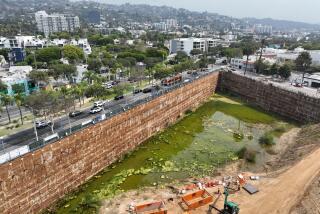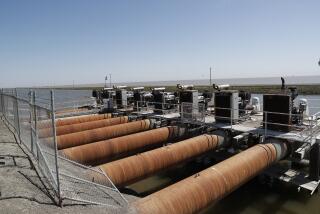Sinkhole Swallows Up 23-Acre Lake, Leaving Homeowners Low and Dry
- Share via
WILDWOOD, Mo. — The names on the street signs seem a mockery:
Waterside Drive. Surfview Court. Pierside Lane. Sailboat Way.
They make sense for a community built around a lake. Trouble is, out here, the lake has vanished.
In one astonishing night last month, a giant sinkhole swallowed all 23 acres of Lake Chesterfield -- leaving a vast, stinky bowl of muck at the center of an upscale subdivision in this suburb on the far western hem of St. Louis County.
“We woke up in the morning and the lake was gone,” said Betty English, 74, who lives in a no-longer-shoreline condo. “I just couldn’t imagine what had happened to all the water.”
What had happened was this: A segment of the limestone bedrock at the bottom of the manufactured lake disintegrated and tumbled into a hollow pit beneath. That collapse created a powerful sinkhole, which sucked in millions of gallons of water in a matter of hours. On June 7, the lake dropped a few feet. On June 8, it dropped a few more. By June 9, it was gone.
The only water left is a shallow puddle at one end and, at the other, a trickle that comes out of a drainage pipe, splashing down on an empty Gatorade bottle and a crumpled barbecue corn chip bag. The rest of the lake -- which was about 10 feet deep -- apparently flowed underground and resurfaced in a spring about four miles to the north.
“Mother Nature’s plumbing system,” said geologist Dave Taylor.
He should know. He has seen hundreds of manufactured lakes disappear across Missouri.
The state’s terrain, known as karst topography, consists in many areas of porous limestone, pitted with gullies and cavities. That creates some awe-inspiring caves. It also invites sinkholes.
“It’s just Mother Nature slowly working away at the crust of the Earth,” said Taylor, who has inspected the mud that was once Lake Chesterfield. “It’s been going on for millions of years.”
That hardly consoles the 2,000 residents of this neighborhood.
“That’s our signature -- that lake,” said Ernest Johansen, 75, who bought a condo when the development opened 16 years ago.
“It looks so forlorn now,” added George English, 74.
In the last month, the Lake Chesterfield Homeowners Assn. has commissioned $30,000 in engineering studies to assess the condition of the bedrock and a nearby dam. An additional $4,000 bought orange safety fencing around the lake to prevent kids from walking on the still-treacherous ground.
The next step is unclear. Taylor’s company, Strata Services, makes a business out of plugging leaky lakes by injecting pressurized concrete grouting into cracks.
But until the engineering studies are complete, he cannot estimate how much the treatment would cost in Wildwood. He also can’t say how effective it would be. For though he feels certain that he can patch the sinkhole, it’s always possible the lake could spring another leak elsewhere.
Indeed, since it was dug in the late 1980s, Lake Chesterfield has developed one crack after another -- all minor compared to the sinkhole, but still costly to repair. Since it’s a private facility, fixing the lake is the sole responsibility of the 676 area homeowners; they pay up to $550 a year to maintain the basin and other amenities.
Some have begun to question whether that’s money well-spent. Especially when nearby construction periodically dumps silt into the basin, turning the water a murky and most unappealing brown.
“When the lake is pretty, it’s very pretty. But things keep happening to it,” said Beverly McVean, 55, a longtime resident. “I’m afraid of what [the repairs] will cost.”
In the last few weeks, the lakebed has sprouted a soft bright fuzz of grass. “It looks like a Chia Pet!” said Teresa Haire, who manages the homeowners association.
The dead fish that reeked so badly in June are long since gone, carried off by hungry birds. There’s no more smell and little mud. The lake looks, in fact, like an expansive park, perfect for soccer fields or baseball diamonds. And some residents would like to see it stay that way.
“I think it’s going to be an astronomical cost to fix the lake ... and even then there’s no guarantee that this won’t happen again,” said Jo Jacaty, 76. “I don’t see why they can’t make it into a park for the children.”
She plans to raise the issue at an upcoming homeowners association meeting. But Jacaty knows many of her neighbors have their hearts set on restoring the lake -- for paddle-boating with the grandchildren, fishing on a summer’s evening or simply enjoying as a picture-postcard view at sunset.
“That’s the whole reason we bought our place here,” English said. “The lake is breathtaking.”
Or, rather, it was.
More to Read
Sign up for Essential California
The most important California stories and recommendations in your inbox every morning.
You may occasionally receive promotional content from the Los Angeles Times.










